|
Symbolism in Castiglione's Immaculate Conception
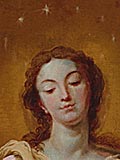 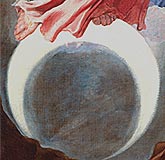
Mary
The essential features of this dramatic type are based on the vision of the "Woman of the Apocalypse" described in the New Testament Book of Revelations (12:1-6). The standing Virgin, fully illuminated and wearing a crown of twelve stars, floats on clouds with a crescent moon beneath her feet. The twelve stars represent the twelve tribes of Israel. Examples of this type also incorporate features of earlier imagery of the Virgin, drawn from verses in the Song of Solomon in the Old Testament. (S. of S. 6:13), describing the Shulammite maiden as "fair as the moon and clear as the sun…" The orange glow behind her head represents the sun. The fusing of Old and New Testament imagery found in the Spanish depiction, as outlined by Pacheco, became universally accepted as the correct visualization of an abstract idea, and it quickly became a popular theme in religious painting.
The other sections of Castiglione's painting reinforce the themes of Mary's purity and status. Both figures kneeling in awe below the Virgin wear the brown robe and cowl of the Franciscans, and the gold rims of their halos indicate they are saints. These saints are appropriate inclusions in the composition, since the church in Osimo belonged to the Capuchin friars, an independent and strictly observant branch of the Franciscans.
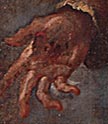 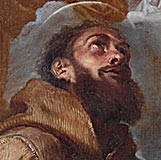 
St. Francis of Assisi
St. Francis of Assisi (about 1182-1226), founder of the Franciscan Order, appears on our left. The cord around his waist is distinguished by three knots representing the religious vows of poverty, chastity and obedience. St. Francis can be recognized by the stigmata on his outstretched hands-the five marks corresponding to Christ's wounds-which the saint received during a vision. The skull, a reminder of man's mortality, is another symbol associated with St. Francis.
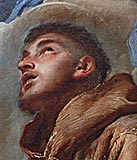
St. Anthony of Padua
St. Anthony of Padua (1195-1231) was a friend and disciple of St. Francis. Among his symbols are the lily, a standard sign of purity also commonly associated with the Virgin Mary, and a book, indicating his great scriptural learning. St. Anthony was well known for his eloquent delivery of the scripture. His arms are crossed over his chest in a deferential gesture of humility.
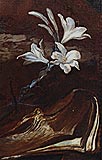
The Background
In its present condition, the lower part of the painting is not clearly legible, and the plants depicted are not immediately identifiable. The thorny plant may refer to the crown of thorns worn by Christ at his Crucifixion, or to the verse equating the Virgin to "the lily among thorns" in the Song of Solomon (II, 2). The thorn bush and flower below it may also symbolize the virtue of chastity. Like others who practiced total sexual abstinence for the sake of their beliefs, St. Francis wrestled with his physical urges, at times throwing himself into a thorn bush. According to a legend, roses sprouted where drops of blood fell to earth.
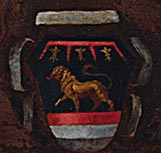
The Coat of Arms
The coat on arms in the lower left is the crest of the Fiorenzi family. The crest let worshipers know that Pier Filippo Fiorenzi paid for the painting. Considering its strange appearance, it is likely the crest was added by an artist other than Castiglione.
| 